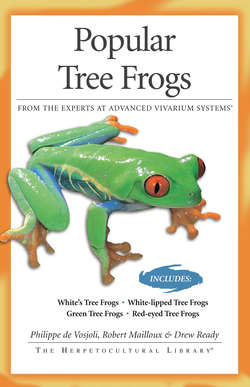Читать книгу Popular Tree Frogs - Robert Mailloux - Страница 8
На сайте Литреса книга снята с продажи.
ОглавлениеCHAPTER 4
DIET AND WATER
Diet
All tree frogs are primarily insectivorous, although large specimens occasionally ingest vertebrate prey. The easiest approach to feeding tree frogs is to offer them commercially raised insects. Use the following guidelines when feeding your frogs:
Gray Crickets (Acheta domestica)
Gray crickets should be a primary component of the diet of captive tree frogs. Most stores that sell amphibians and reptiles also sell these crickets in a variety of sizes suitable for feeding a wide range of tree frogs, from newly metamorphosed froglets to much larger species. Feeder crickets should be about the same length as the head of the tree frog. This general rule works with other kinds of food items also, even mice. Before offering the insects to your tree frogs, house them in a small plastic terrarium for twenty-four hours and feed them a high-quality diet (see page 23).
Flies
You can purchase housefly maggots through mail order companies and keep them in jars or screened enclosures until they pupate and metamorphose. Using houseflies is a cheap way to feed large numbers of froglets and provide a good supplemental food for adult tree frogs. They are best used in greenhouse facilities, where escaped flies will not be as much of an annoyance as in your home. However, if you allow them to pupate in jars, you can funnel them into a vivarium with a nylon stocking; cut off the toe-end of the stocking, attach it to the pupating jar, and guide the flies from the jar into the frog vivaria.
Fruit Flies
The large flightless fruit fly (Drosophila hydei) is a good supplemental dietary item for froglets (check Reptiles and Reptiles USA for mail order sources). These flies are easy to raise using a standard fruit fly mix, which is available by mail order or through biological supply houses.
Mealworms and Superworms
Mealworms (Tenebrio molitor) and superworms (Zophobas molitor) should be offered to tree frogs only as part of a varied diet. White mealworms (recently molted) are more easily digested and are preferable as a diet to chitinized ones. Larger tree frog species fare better than smaller species on diets that include mealworms, particularly superworms.
